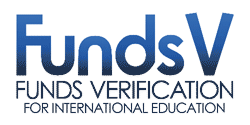International Educators
- About USjournal.com, LLC
- Advertising / Promotional Options
- Advertising Rate Card (pdf)
- Academic Program Listing (pdf)

- Current USjournal.com Advertisers
- Current USjournal.com Services
- Follow USjournal on LinkedIn
- FundsV Named Innovation Finalist
- Growth in Online Language Usage
- Multi-lingual Campaign Advantages
- SkyRadio Audio Segment (wma)
- Strategic Partnership with USDOC

- USjournal.communique
- USjournal History
- USjournal Innovation Lab
| usjournal.communiqué: eRecruitment Trends and Techniques March 2002
eRecruitment's Place in the Enrollment Funnel |
When structured optimally, online international student recruitment is a dream come true for admissions counselors, enrollment managers and marketing experts. Ethical e-mail promotional campaigns are often referred to as "permission-based marketing strategies," as opposed to online pop-up ads or television commercials, for example, which are more "interruptive" in nature. In essence, targeted internet campaigns can be structured so prospective students provide pertinent personal information as an *invitation* to correspond with them about particular programs. From that perspective, it's easy to understand why e-Recruitment can be so effective, because inquiries from this medium are further down the proverbial Enrollment Filter:
* * * * * Recruitment * * * * *
* * * Application * * *
* Yield *
Recruitment: At the widest part of the Enrollment Filter, the objective is to analyze a particular campus' internal objectives and capabilities to determine the who, what, where, when and how of a marketing strategy. In international education, the good news is that the whole world is our market; the bad news is that the whole world is our market. On the positive side of the spectrum, we need to enroll only a tiny fraction of the hundreds of thousands of students around the world who would love to study in the States. On the other hand, the concept of a truly global market may be overwhelming to some. Thankfully, you can't be all things to all people. A comprehensive internal evaluation helps to focus your efforts when you decide to cast your net during the recruitment stage of the Enrollment Funnel.
Application: Take advantage of proven technologies for this section of the Enrollment Funnel. The Recruitment and Yield sections require a lot of human input, but the Application process is the perfect opportunity to intelligently filter through only those students who are most likely to enroll in your particular programs, as you define them. Click here for details of our successful model. Via technological advances such as Automated Responses, re-direct the prospective students who do not qualify for your programs; for example, if the student does not have adequate funding, suggest links to scholarship sites or other less expensive academic options such as short-term courses. It's important to respond to every e-inquiry, as a matter of courtesy. Mountains of e-mail messages are manageable, with the proper tools in place.
Yield: Of the three stages of an Enrollment Funnel, allocate the most time and energy to the Yield stage; i.e., you must do more than simply send a brochure, and hope for the best. Admissions counselors on your own campus are most qualified to handle this conversion of inquirer to enrollee, because they should know your campus better than anyone else. Recognize that, in spite of all our technological advances, the admissions decision is still largely made on personal interaction between prospective student and admissions counselor. A sense of sincerity in the prospect's academic and social success needs to begin long before he or she steps foot on campus. That nurturing can happen with e-mail -- the preferred mode of communication for a significant portion of worldly students around the globe.
At the U.S. Journal of Academics, we focus on the Application stage of the Enrollment Funnel. Through our interaction with literally hundreds of international admissions counselors each month, we've learned that our most successful advertisers are those who recognize the value of the inquiries we provide for their Yield stage. Through usjournal.com, prospective students request information about specific programs; we do not dilute any inquiry by sending it to hundreds of U.S. campuses. And about 35 percent of our student traffic inquire about just one single program, after researching their options within our site. That's in stark contrast to just a few years ago, when the average student submitted their inquiry to 20 or 30 different advertisers through us. Like the rest of us, these students are reluctant to provide their personal information to any random organization. In our case, the student is asking our sponsors to correspond with him or her. Effective follow-up systems include telephone calls, e-Mail Ambassadors, regular e-correspondence, better utilization of your current website, and other proven strategies.
The U.S. Journal of Academics leads the way in online international student recruitment. Our innovative, copyrighted system's sophisticated mechanisms include customized, automated e-mail responses based on the student's input; instant forwarding of the student's inquiry to the usjournal.com sponsor; timely Excel Reports of all student inquiry activity for each sponsor; multi-lingual capabilities; and much more! Click here for complete details.
We would be delighted to assist you in enhancing your global promotional efforts. Call us at 570-339-4731, or e-mail cheryl@usjournal.com for more info. Thanks!
You are welcome to re-print this usjournal.communiqué in full, under the condition that you include "Reprinted with permission of Cheryl Darrup-Boychuck, U.S. Journal of Academics, cheryl@usjournal.com."
Please let us know if you have other suggestions for topics in usjournal.communiqué. If you would like to subscribe to this brief e-newsletter, please complete the form. Thanks!

